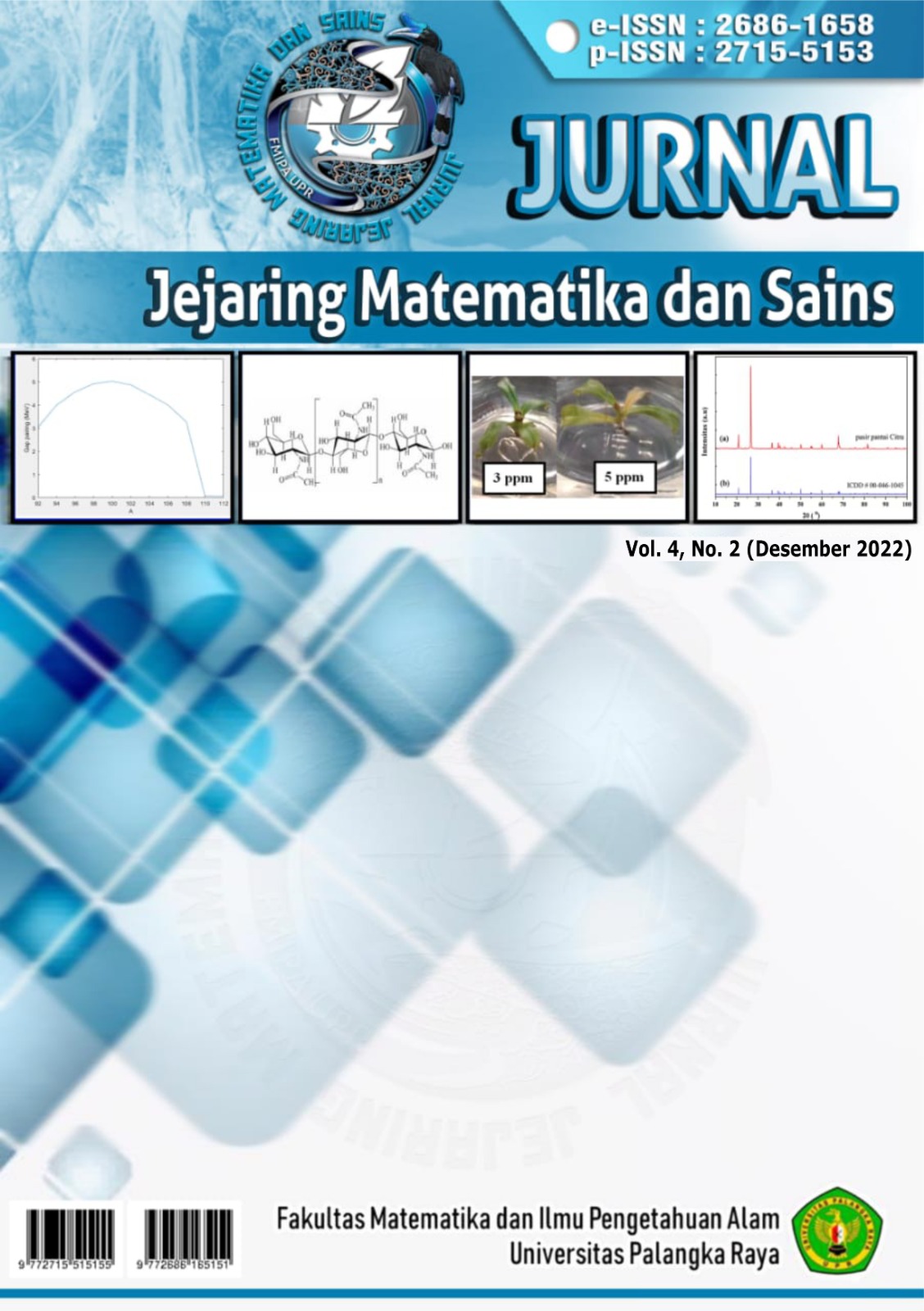Chemical Kinetic Study on Saponification Reaction of Ethyl Acetate Using Titration and Conductometric Methods
Studi Kinetika Kimia Pada Reaksi Saponifikasi Etil Asetat Dengan Metode Titrasi dan Konduktometri
DOI:
https://doi.org/10.36873/jjms.2022.v4.i2.710Keywords:
chemical kinetics, saponification, ethyl acetate, reaction order, rate constantAbstract
A chemical kinetics study on the saponification reaction of ethyl acetate by comparison of titration and conductometry methods has been conducted. First, though, this study started by reacting ethyl acetate with NaOH with a volume ratio of 2: 3 and was kept at a constant temperature of 35oC. The process of determining the order and rate constant of saponification reaction of ethyl acetate by hydroxide ions was carried out by comparing the analysis results with titration and conductometry methods with time variations of 5, 10, 15, 25, 40, and 60 minutes. The study's results proved that the saponification reaction follows the kinetics of the 2nd order reaction. It is supported by the analysis results using both analysis methods at time variations and obtaining a linear line graph with a positive gradient and an R2 value of 0.9757 and 0.9955, respectively, where both values are close to 1. Based on the titration method, the reaction rate (k) rated ethyl acetate saponification obtained a yield of 3.2375 M-1.min-1, while by the conductometry method, the rated value of the reaction rate obtained was 13.1973 M-1.min-1.
Downloads
References
R. A. Sinanto and S. N. Djannah, “EFEKTIVITAS CUCI TANGAN MENGGUNAKAN SABUN SEBAGAI UPAYA PENCEGAHAN INFEKSI : TINJAUAN LITERATUR,” J. Kesehat. Karya Husada, vol. 8, no. 2, pp. 19–33, Oct. 2020.
A. Widyasanti, P. S.H., and D. S. N. P., “Upaya Pemberdayaan Masyarakat Melalui Pelatihan Pembuatan Produk Sabun Berbasis Komoditas Lokal Di Kecamatan Sukamantri Ciamis,” J. Apl. Ipteks untuk Masy., vol. 5, no. 1, pp. 29–33, 2016.
S. T. Mabrouk, “Making Usable, Quality Opaque or Transparent Soap,” J. Chem. Educ., vol. 82, no. 10, p. 1534, Oct. 2005.
A. Kuntom, H. Kifli, and P. K. Lim, “Chemical and physical characteristics of soap made from distilled fatty acids of palm oil and palm kernel oil,” JAOCS, J. Am. Oil Chem. Soc., vol. 73, no. 1, pp. 105–108, 1996.
D. S. Retnowati, A. C. Kumoro, and C. S. Budiyati, “Pembuatan dan Karakterisasi Sabun Susu dengan Proses Dingin,” J. Rekayasa Proses, vol. 7, no. 2, p. 46, 2013.
V. I. Sari, “PEMANFAATAN STEARIN DALAM PROSES PEMBUATAN SABUN MANDI PADAT Vonny Indah Sari* Program Studi Teknik Pengolahan Sawit, Politeknik Kampar,” Agric. Sci. Technol. J., vol. 11, no. 1, pp. 1–10, 2012.
A. Sorrenti, O. Illa, and R. M. Ortuño, “Amphiphiles in aqueous solution: well beyond a soap bubble,” Chem. Soc. Rev., vol. 42, no. 21, p. 8200, 2013.
P. Naomi and A. M. L. Gaol, “PEMBUATAN SABUN LUNAK DARI MINYAK GORENG BEKAS DITINJAU DARI KINETIKA REAKSI KIMIA,” J. Tek. Kim., vol. 19, no. 2, pp. 42–48, 2013.
P. Prayitno, “Kajian Kinetika Kimia Model Matematik Reduksi Kadmium Melalui Laju Reaksi, Konstante Dan Orde Reaksi Dalam Proses Elektrokimia,” GANENDRA Maj. IPTEK Nukl., vol. 10, no. 1, pp. 27–34, 2007.
D. Fathmawati, M. R. P. Abidin, and A. Roesyadi, “Studi kinetika pembentukan karaginan dari rumput laut,” J. Tek. Pomits, vol. 3, no. 1, pp. 27–32, 2014.
H. Widodo, E. Kustiyah, Y. Trihusodo, and A. Annisa, “STUDI PENENTUAN UMUR SIMPAN MINYAK SAWIT DENGAN METODE ACCELERATED SHELF LIFETESTING,” Barometer, vol. 4, no. 2, Jul. 2019.
A. Mukhtar, U. Shaiq, Q. Mo, H. A. Qad, M. Qizilbash, and B. Awan, “Kinetics of Alkaline Hydrolysis of Ethyl Acetate by Conductometric Measurement Approach Over Temperature Ranges ( 298.15-343.15K ),” Austin Chem Eng, vol. 4, no. 1, pp. 1–11, 2017.
A. Salendra, A. A.-J. K. Khatulistiwa, and U. 2018, “Saponifikasi asam lemak dari lumpur minyak kelapa sawit (sludge oil) menggunakan basa abu sabut kelapa,” J. Kim. Khatulistiwa, vol. 10, no. 1, pp. 2685–1229, 2019.
M. Hájek and F. Skopal, “Treatment of glycerol phase formed by biodiesel production,” Bioresour. Technol., vol. 101, no. 9, pp. 3242–3245, May 2010.
M. Zan, X. Wang, A. Amuti, Z. Wang, and L. Dang, “Saponification of peony seed oil using response surface methodology,” Ind. Crops Prod., vol. 173, pp. 114–134, Dec. 2021.
R. Justi, “Teaching and Learning Chemical Kinetics,” in Chemical Education: Towards Research-based Practice, Dordrecht: Kluwer Academic Publishers, 2002, pp. 293–315.
O. A. El Seoud, W. J. Baader, and E. L. Bastos, “Practical Chemical Kinetics in Solution,” in Encyclopedia of Physical Organic Chemistry, 5 Volume Set, Hoboken, NJ, USA: John Wiley & Sons, Inc., 2016, pp. 1–68.
H. Shekaari, M. T. Zafarani-Moattar, and S. N. Mirheydari, “Conductometric analysis of 1-butyl-3-methylimidazolium ibuprofenate as an active pharmaceutical ingredient ionic liquid (API-IL) in the aqueous amino acids solutions,” J. Chem. Thermodyn., vol. 103, pp. 165–175, Dec. 2016.

Downloads
Published
How to Cite
Issue
Section
License
Copyright (c) 2023 Jurnal Jejaring Matematika dan Sains

This work is licensed under a Creative Commons Attribution-NonCommercial-ShareAlike 4.0 International License.
















